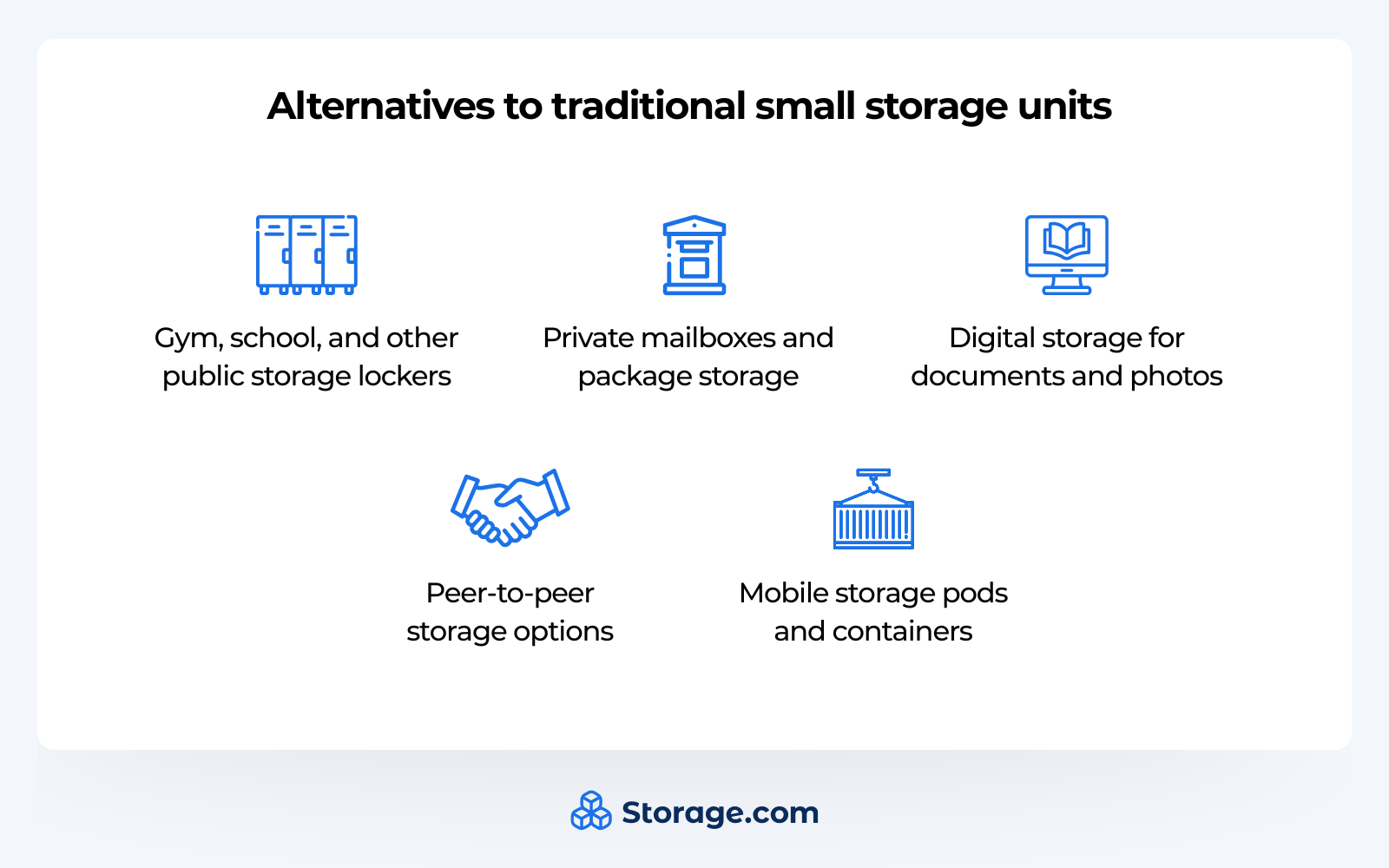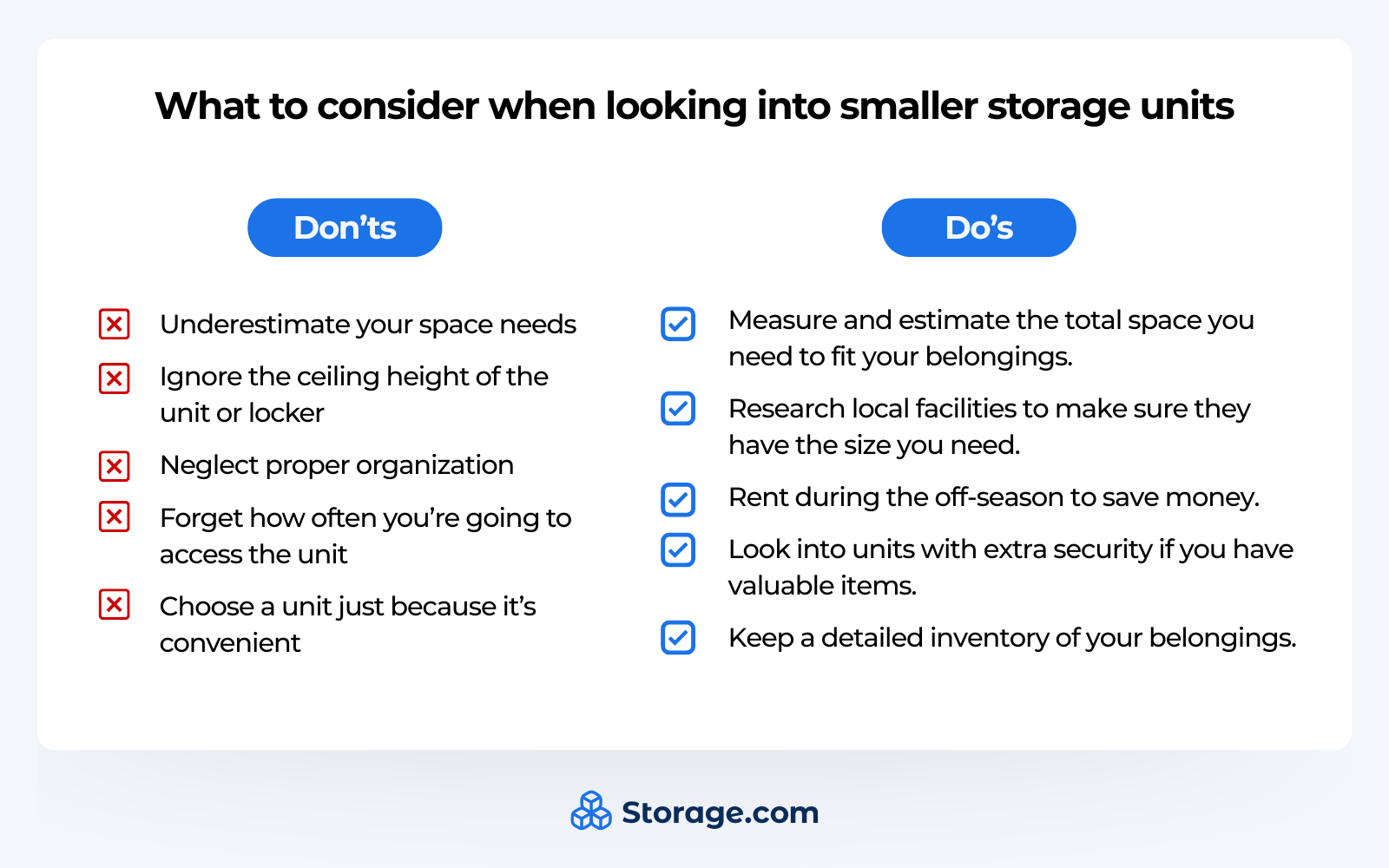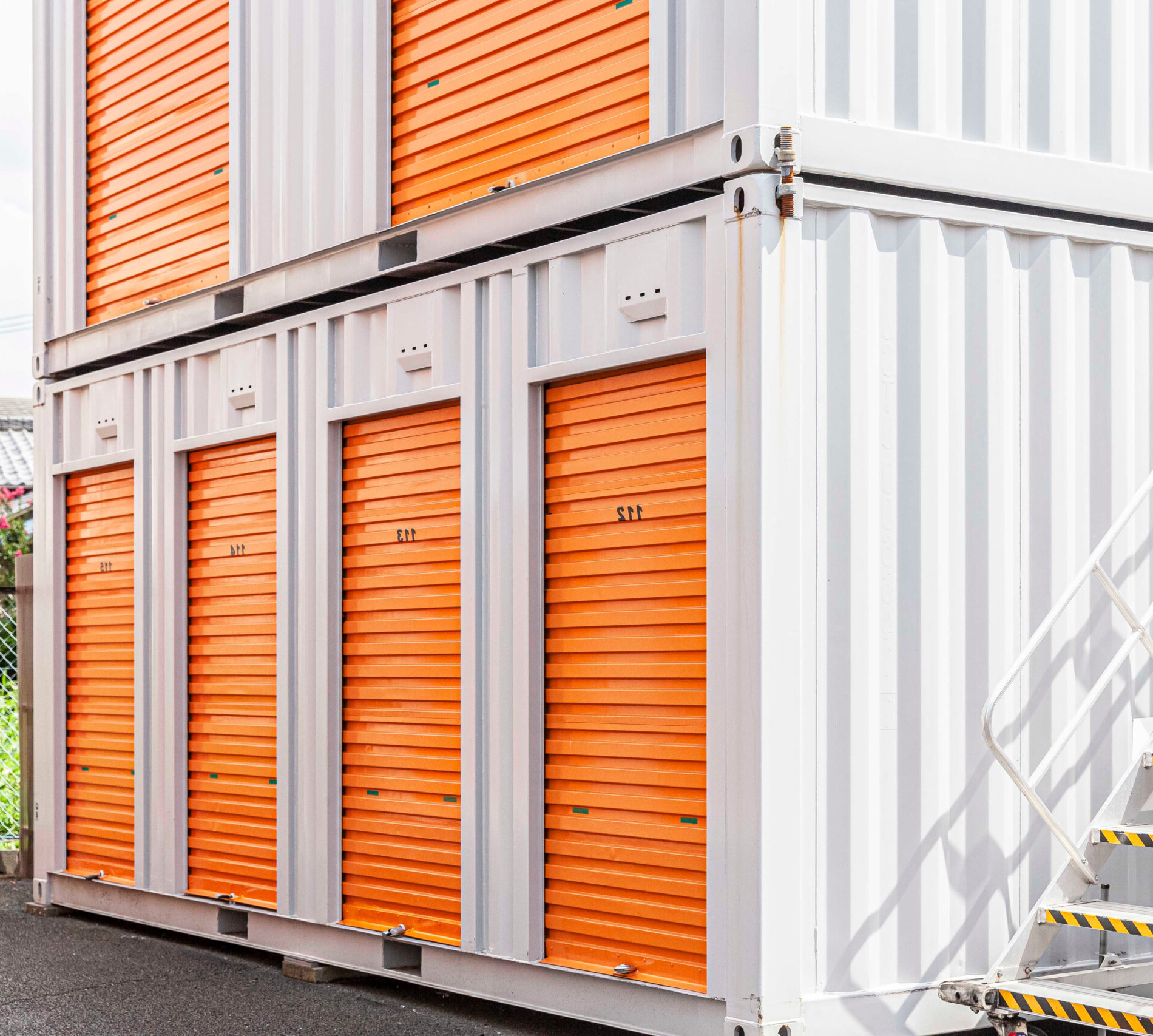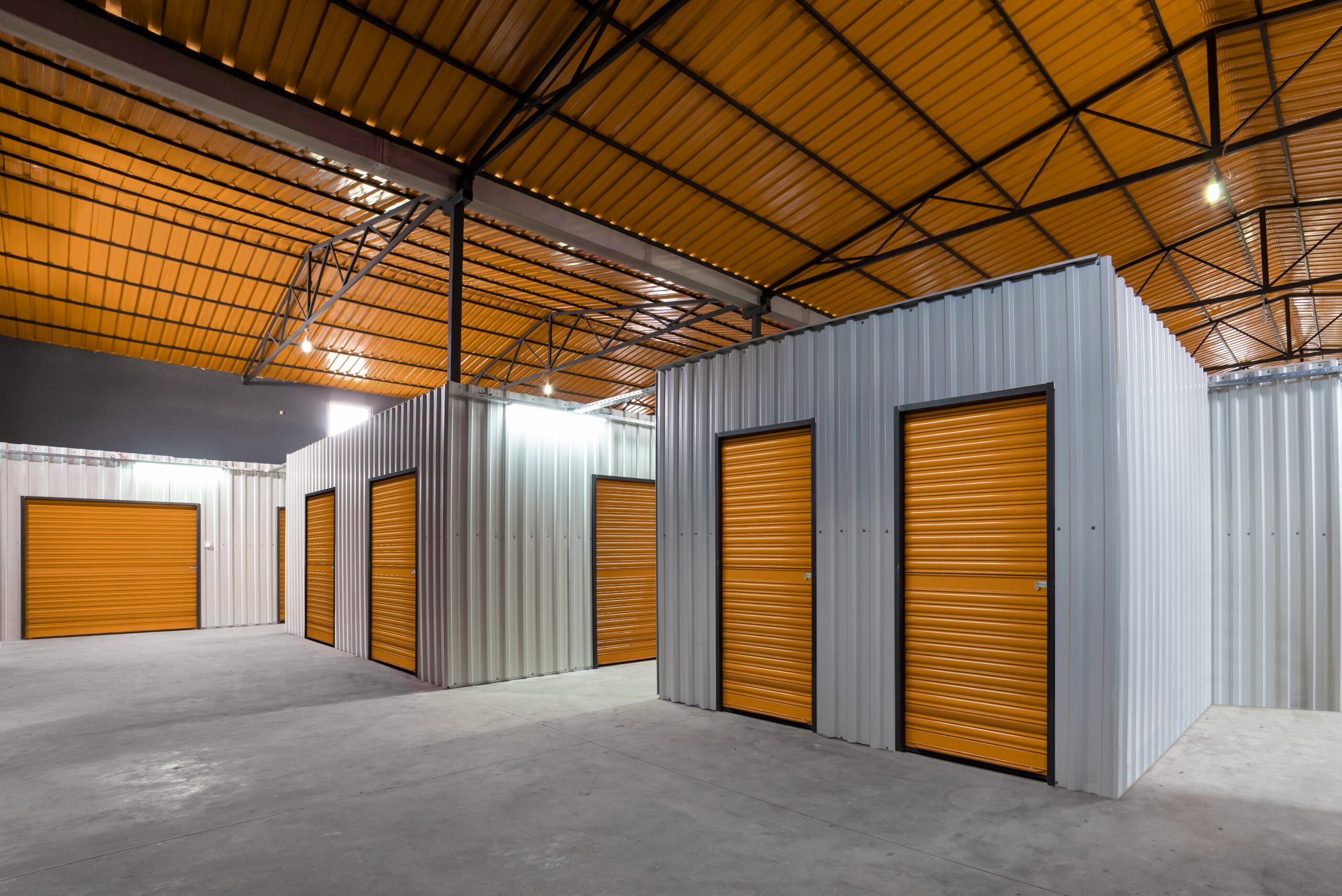Article takeaways
- The smallest storage unit sizes available at most facilities are 5×5 and 5×10 full-height units.
- Some facilities offer 3×3 storage lockers for renters who don’t require a full unit’s worth of space.
- Take a detailed inventory of your items and make use of vertical space when renting to get the most out of a smaller unit.
In recent years, more and more homeowners and renters have been drifting towards living in smaller spaces and owning less to save money and downsize their lives. City dwellers in particular tend to live in smaller spaces, and when they need extra storage space, they may not want to rent an entire self-storage unit if they don’t need one. Luckily for them (and for you, if you’re one of those people), there are plenty of small storage units available for those looking to save money and space while getting some of their belongings out of the way.
There are plenty of options available if you’re looking into smaller storage units, from 5×5 and 5×10 closet-size units to even smaller storage lockers (3×3). In this article, we’ll go over some of these units and how they can meet your storage needs while going easy on your wallet.
What is a Mini Storage Unit?
If you’re looking to just store a couple of boxes or one or two pieces of furniture, a mini storage unit may be exactly what you need. These units typically range from 5×5 to 5×10, providing just enough space to store a few important items you want to get out of the way. Some “mini” units will have low ceilings, however, so be sure to research height limitations before investing in one.
Facilities that provide these units will use terms like “mini” and “small” units, but these can vary, so identify what specific sizes these labels refer to when researching and touring facilities. Mini storage units are more likely to be available in indoor storage facilities, as they’re easier to build and maintain in these locations rather than in larger outdoor facilities.
Why Should I Consider a 5×5 Mini Storage Unit?
The most common “mini” storage unit size is 5×5, approximately the same size as a large walk-in closet. These units are perfect for storing seasonal clothing you want to get out of your apartment, smaller furniture pieces like nightstands and smaller dressers, and holiday decorations. You’ll also find these units are ideal for storing personal memorabilia and small appliances, and other electronics.
To maximize space in a 5×5 unit, you’ll want to take advantage of what vertical space is available, as horizontal space will be limited. Stack lighter and more fragile boxes on top of heavier and more robust ones, fill up the wall space before anything else, and if you can, leave space in the center for you to walk into and inspect your unit.
Why Should I Consider a 5×10 Storage Unit instead of a 5×5?
If you find you need more than a closet’s worth of space to store some of your goods, consider a 5×10 storage unit, about the same size as a small bedroom. The additional space in this size of unit will let you store more and larger pieces of furniture from a studio apartment, seasonal outdoor equipment such as gardening tools, inventory for a small business, or even the contents of a college dorm room.
Making a detailed comparison between the storage unit sizes available to you is key to deciding what to rent. If you’re getting a better deal per square foot with a larger unit, consider renting the 5×10 over the 5×5. You’ll also want to make this decision if you want extra space for future storage needs or easier access to the items within your unit.
What are Storage Lockers?

If you’re looking to store just a few items and don’t need an entire walk-in storage unit, a storage locker may be exactly what you need. Storage lockers are typically 3×3 storage units with much more limited height; you can’t walk into them, but you can easily insert and remove items from the hallway. You’re more likely to find lockers in an indoor storage facility, and they’re most often provided in larger cities where smaller living spaces are more common.
Storage lockers are ideal for storing documents such as health care files, small valuables, and small amounts of seasonal clothing, as well as providing temporary storage for limited items during a move or items a college student may need to remove from their dorm to save space. While they have limited space and limited amenities, these limits come with a lower price that may benefit any renters who don’t need an entire unit to store their belongings.
How Can Smaller Storage Units Help Me Save Money?
Small and mini storage units are often the most cost-effective option for customers with limited storage needs. Depending on the amenities the facility provides, you can expect to pay $40-$90 per month for a 5×5 unit; if you have a higher budget, consider a 5×10 unit, and if you have a lower budget, a storage locker may be what you need. These prices may increase in larger cities, and if you plan on investing in a climate-controlled unit.
Smaller storage units provide a lower barrier to entry for first-time renters, giving them a cost-effective option to try out self-storage for the first time while providing them with extra flexibility. These units cost less to insure, and the limited space gives renters less temptation to either overfill the unit or waste money on space they don’t need.
If you’re looking to save even more money on renting a storage unit, plan to rent during off-seasons, as many facilities offer promotional pricing and discounts to entice renters during slower periods of the year. Smaller units come with their own promotional rates, and you may find you can save extra money by bundling a storage unit rental with a moving service.
What Alternatives Can I Find to Traditional Small Storage Units?

There are a number of reasons a small self-storage unit may not be right for you. Thankfully, there are plenty of other options worth looking into if that’s the case.
- Gym, school, and other public storage lockers. If your needs are specific and your items are limited, these lockers may be just what you need. For example, your gym membership can give you a small locker to store gym equipment that might be taking up space in your home otherwise. High school and college students can use lockers on campus to store school supplies during the year.
- Private mailboxes and package storage. If you receive a lot of mail and need somewhere to store it, you can rent a P.O. box or a private mailbox to collect mail in and empty it out when you need it.
- Digital storage for documents and photos. Scanning or otherwise digitizing important documents before disposing of the physical copies will save physical space, and a secure hard drive or cloud service will keep them safe from prying eyes. Digital photographs can also be stored with these services.
- Peer-to-peer storage options. Similar to an Airbnb, you can sometimes find everyday people willing to rent out secure spaces in their home for your goods–just be sure you choose a reputable provider.
- Mobile storage pods and containers. Best for moving needs and renters who need large amounts of additional space, mobile storage pods enable you to load several belongings into them before they’re picked up and stored by the pod provider. You can then order them to be dropped off at a destination if you’re moving.
How Do I Choose the Right Small Storage Unit?
When you’re shopping for storage, make sure you have a solid inventory of what items you want to store so you know how much space they’ll take up. You should also consider how often you’ll need to access the unit, how close you’d like it to be to your current home, and how much extra space you might need in the future. Use these to determine what size unit is right for you.
Once you’ve figured this out, find out what facilities near you offer the options you need. Look into indoor units for the most security; units on the ground floor are easier to access, but units on upper floors will be harder to break into, so consider which is more important to you. Find out whether the facility you’re considering has a robust security system in case you’re storing valuables, and consider a climate-controlled facility if you’re storing documents or other items that may be damaged by temperature and humidity changes.
How Do I Maximize Space in a Mini Storage Unit?
To make the most of a smaller storage unit, make use of the vertical space you have available. You can bring your own small shelves for some units, giving you a sturdy place to store items while making the most of the standard eight-foot ceiling. Any boxes or tubs you’re storing could potentially be stacked to save space, but be sure you stack light items on top of heavy ones.
Vacuum-sealing clothing that you’re storing will both save space and protect it from the elements, so look into vacuum bags for this purpose. Clearly label your boxes and keep a detailed inventory of what you have stored, and leave some open horizontal space to enable you to get into the unit and easily swap out boxes when needed, especially when seasons change and you’re storing seasonal items.
What “Dos and “Don’ts Should I Consider When Looking into Smaller Storage Units?

Do:
- …measure and estimate the total space you need to fit your belongings.
- …research local facilities to make sure they have the size you need.
- …rent during the off-season to save money.
- …look into units with extra security if you have valuable items.
- …keep a detailed inventory of your belongings.
Don’t:
- …underestimate your space needs. Renting a unit that’s too small for your needs will leave you with several items you won’t know where to store. It’s better to have too much space than not enough space.
- …ignore the ceiling height of the unit or locker. It’s difficult to maximize vertical space when there’s no vertical space to maximize, so pay attention to how high you’re able to stack items in a mini storage unit.
- …neglect proper organization. Messy organization will lead to wasted space and clutter in your unit, making it difficult to store everything you need and find the items you’re looking for when the time comes.
- …forget how often you’re going to access the unit. Part of storage means organizing items so you can easily find anything, no matter how often you visit. Leave some horizontal space for you to enter and look around.
- …choose a unit just because it’s convenient. An easier-to-access unit without enough space is basically useless. Consider unit size first of all, before factoring in the facility’s location and where the unit is located within the facility.
Where Should I Look for Small Storage Units that Meet My Needs?
As you’ve seen, if you need some extra storage space but don’t need a massive unit, there are plenty of self-storage options available from small lockers to 5×5 units. These smaller sizes are some of the most affordable options out there, and are easy to access if you choose the right location for you. If you’re a first-time storage unit shopper, you can save on up-front costs by starting small, then seeking out larger units if you end up needing the extra space.
If you’re serious about your storage search, let Storage.com help you out. Use our built-in search tool to find storage facilities near you that have the mini storage unit sizes and amenities you require, or give us a call at (833) 389-5401 to speak to a storage expert and get personalized help.
Looking for a larger storage space than traditional storage units? Check out our guide on maxi storage here.






